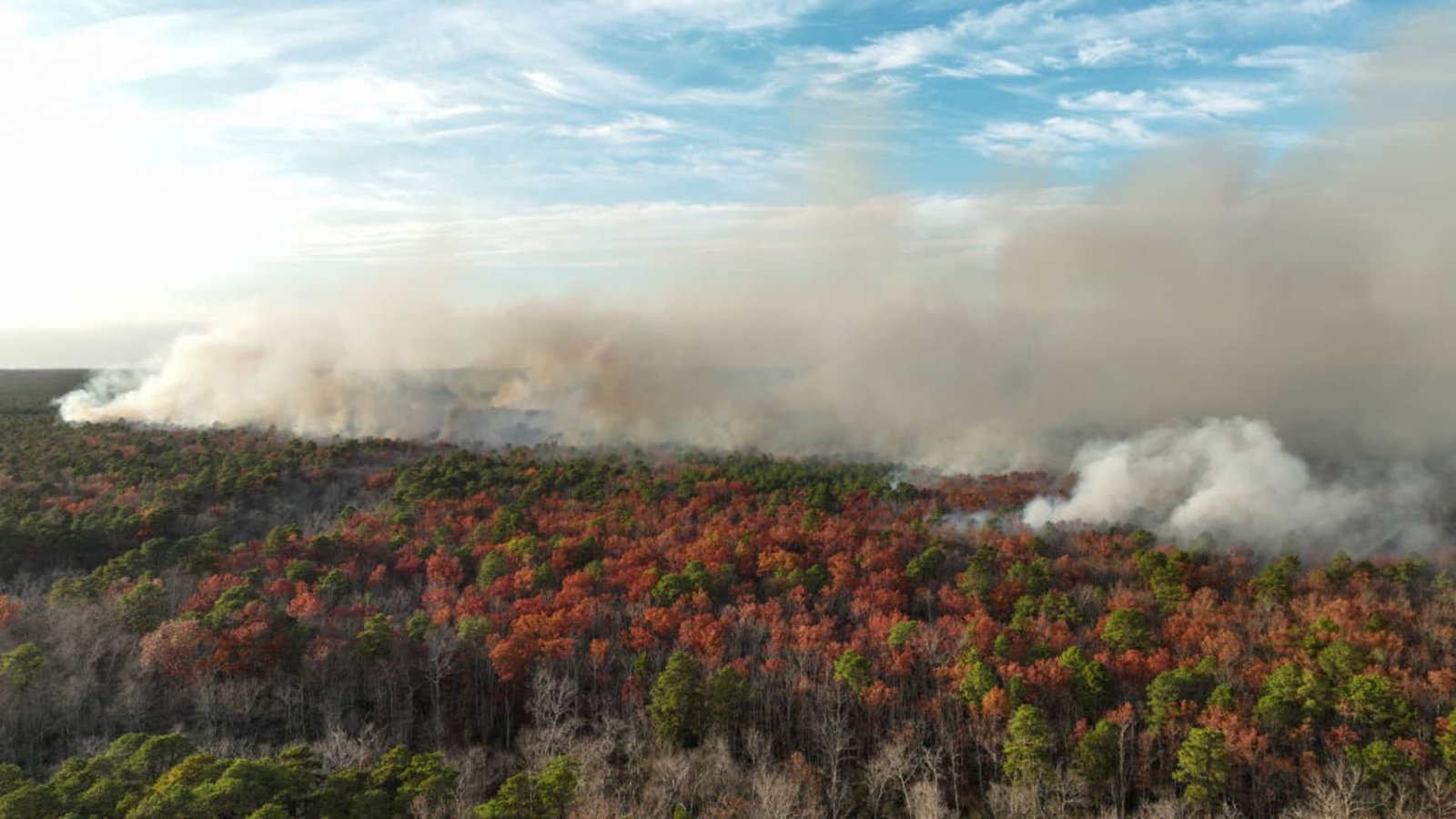
Several homes were evacuated as a wildfire spread through the Colliers Mills Wildfire Management Area in Ocean County, New Jersey.
Lokman Vural Elibol/ | Anadolu | Getty Images
Dry and unseasonably warm conditions in the Northeast have plunged much of the region into drought, fueling wildfires in New Jersey, Connecticut and Massachusetts.
October ended as one of the driest months on record in the U.S., according to the National Oceanic and Atmospheric Administration. The Northeast, in particular, saw scant precipitation.
Cities such as Philadelphia; Newark, New Jersey; Wilmington, Delaware; and Norfolk, Virginia, recorded no rain at all in October, according to the Southeast Regional Climate Center, which collects precipitation data from more than 1,400 weather stations across the country. Several cities, including Philadelphia and Washington, D.C., set new records for the number of consecutive October days without any measurable rainfall.
“This is a region that we don’t typically associate with drought,” said Benjamin Cook, an adjunct research scientist at the Lamont-Doherty Earth Observatory in Palisades, New York. “To have such persistent periods of really intense drought conditions is not very common.”
The dry spell has not let up in the first week of November, with much of the region in the grips of “severe” drought, as classified by the U.S. Drought Monitor, which tracks conditions nationwide and releases weekly color-coded maps to show the extent and intensity of drought.
The Drought Monitor’s latest map, released Thursday, showed drought conditions expanding from Virginia, Pennsylvania and New York up into Massachusetts and Maine. Dry conditions have intensified in some states, with parts of New Jersey, Pennsylvania, West Virginia and Maryland now in “extreme” drought.
“Extreme drought is basically a 1-in-25-year type of drought event,” said Brian Fuchs, a climatologist at the National Drought Mitigation Center at the University of Nebraska-Lincoln, and one of the authors of the U.S. Drought Monitor’s maps.
Several homes were evacuated as a wildfire spread through the Colliers Mills Wildfire Management Area in Ocean County, New Jersey.
Lokman Vural Elibol/ | Anadolu | Getty Images
Drought watches and warnings have been declared in New York, New Jersey and Pennsylvania, with calls to the public to voluntarily reduce water use.
The region’s dry and warmer-than-usual weather has been caused, in part, by a strong high-pressure ridge that parked itself high in the atmosphere over much of the country for several weeks. Across the Northeast, Great Lakes and South, temperatures were 15 to 30 degrees Fahrenheit higher than normal for late October and early November.
More than half of the continental U.S. is experiencing some level of drought. That includes 56% of the Northeast, according to the Drought Monitor.
“A lot of this isn’t because of what happened in a single week,” Fuchs said, “but really the accumulation of the dryness, and the above-normal temperatures in the region too, where week after week, we haven’t seen this pattern break.”
As with any extreme weather event, it will take time to assess how climate change is contributing to the current drought, but Fuchs said that overall, global warming is driving higher-than-average temperatures throughout the region, which dry out land and vegetation.
Climate change effectively “supercharges” the water cycle — the way water naturally circulates between the ground, oceans and atmosphere. Although drought is the most urgent threat, the Northeast is also broadly getting rainier as a result of climate change, because a warmer atmosphere can hold more moisture. So when storms do roll through, more rain can fall over land, which increases the risk of flooding.
Fuchs said such rapid flips between extremes were precisely what the government’s Fifth National Climate Assessment predicted. The report, released in 2023, detailed climate change’s impacts on the U.S. at the time and in the future.
Several homes were evacuated as a wildfire spread through the Colliers Mills Wildfire Management Area in Ocean County, New Jersey.
Lokman Vural Elibol/ | Anadolu | Getty Images
“It’s either wet or dry, and we don’t have these transition periods,” Fuchs said. “That is definitely one of the known impacts of climate change. We go from one regime to the next — wet to dry, dry to wet — and it seems like that’s happening more rapidly.”
In the Southeast, for instance, hurricanes Helene and Milton soaked the region and caused catastrophic flooding in Florida and North Carolina. But since then, some areas have experienced record dryness, Fuchs said.
“When you look at the Drought Monitor map this week and you see all this color in the Southeast, you might be like, ‘Well, didn’t they just have historical flooding not too long ago?’ That’s absolutely right, but it’s been historically dry since then,” he said. “That’s just one example, but the Northeast isn’t immune to that, either.”
In the West, 44% of the region is experiencing some level of drought. In California this week, dry, windy conditions prompted “red flag” warnings for millions of residents. The Mountain Fire in Ventura County has already burned nearly 20,000 acres and prompted 14,000 evacuation notices since it broke out Wednesday morning.
At the same time, the Northeast faces dangerous fire weather, too: Every part of New Jersey is at “very high” or “extreme” risk of fires, according to the state’s Forest Fire Service.
The service said it responded to 507 incidents in October. A blaze that broke out Wednesday in Ocean County forced residents of more than a dozen homes to evacuate.
Meanwhile, firefighters in Connecticut have been battling more than 100 brush fires. Gov. Ned Lamont declared a state of emergency for the state on Oct. 25 because of “critical fire weather conditions” brought on by the lack of rain. The Connecticut Division of Emergency Management and Homeland Security said Wednesday that Connecticut still faces “extreme fire danger.”
Long-range forecasts from NOAA’s Climate Prediction Center show that drought will likely persist in the Northeast through November. Come winter, conditions are expected to improve through January, but parts of Massachusetts, New Jersey, Delaware and West Virginia will likely still experience some level of drought.






